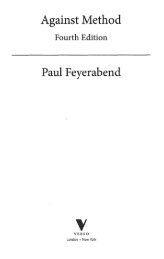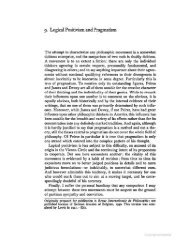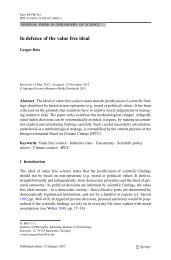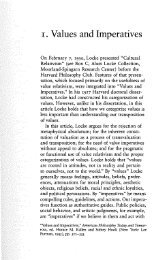Ethnographic Research - Matthew J. Brown
Ethnographic Research - Matthew J. Brown
Ethnographic Research - Matthew J. Brown
- No tags were found...
You also want an ePaper? Increase the reach of your titles
YUMPU automatically turns print PDFs into web optimized ePapers that Google loves.
ETHNOGRAPHIC DATAsynthesizing field notes. These skills can be learned if youdo not already possess them.To be an effective participant observer, though, youalso will need certain attitudes and sensitivities. Youwill need to be capable of and comfortable with fadinginto the background of a social situation-what Lindlof(1995) called a tolerance for marginality. You also willneed to be sensitive to all the verbal and nonverbal communicationcues that are available in a social setting, notjust visual and auditory cues. Instead, we can "open upour sensing to the tastes, smells, tempers, touches, colors,lights, shapes, and textures of the cultures we study"(Lindlof, 1995, p. 138). Finally, to be an effective participantobserver, you will need to be good at "giving people.the benefit of the doubt, getting along by going along,and not being overly querulous or contentious" (Fine,1993, as cited in Lindlof, 1995, p. 139). If you are observingyourself, you will need to use all of the skills we justmentioned, and you will need to develop reflexivity:A researcher must reflect on their own experiences inorder to discern how they are both product and producerof a given cultural phenomenon. However, rather thanlapse into solipsism or catharsis, the researcher must articulatesuch moments so as to engender similar reflection inthe reader, so that the reader might understand how theystand in relation to the same phenomenon. (A. F. Wood &Fassett, 2003, p. 288)Participant observation will allow you to see what themembers do and say in their setting; interviews with keyinformants, on the other hand, will help you to describewhat members report that they do and say and what sensemembers make of those actions and interactions. Forexample, you may observe the stories participants tell, towhom those stories are told, where, with what structures,forms of elaboration, and so on. The stories participantstell one another in their natural settings may be quite differentthan the stories they relate to you, the researcher inthe context of an interview. Thus, observations provide adifferent window into the participants' worlds than doesparticipants' talk about their world. Interviews with keyinformants are one of the ethnographer's methods foruncovering participants' talk about their world.Interviews With Key InformantsCompared to the individual or focus group interviewsthat you learned about in chapter 7, "Survey <strong>Research</strong>:'the ethnographic interview is "the most informal, conversational,and spontaneous form of interview" (Lindlof,1995, p. 170). <strong>Ethnographic</strong> interviews take the forms ofconversations and storytelling between participants andresearchers. The interview is a way to find out things thatyou cannot directly observe (Newman & Benz, 1998;Patton, 1990).Just as selecting participants to interview is criticalto your participation in and observation of a setting,establishing rapport with in.formants is essential if youare to gain useful interview data. Rapport means that thepeople you interview and observe feel comfortable withyou and trust you; it-does not mean that they see you asnaIve, "or an easy target for deception" (Madison, 2005,p. 32). Your demeanor and appearance, listening skills,and nonverbal style all contribute to your effectiveness asa human research instrument in the interview process. Ina collaborative ethnography, you may want to use interviewertraining to ensure that interviews are conductedconsistently (i.e., interactions with one informant arecomparable to interactions with another informant, andinterviews conducted by one researcher are comparableto interviews conducted by another researcher workingon the same research project).You may want to revie'Ythe information in chapter 7, "Survey <strong>Research</strong>:' oninterviewer training as well.There are three main forms of ethnographic interview:(1) "oral history which is a recounting of a socialhistorical moment reflected in the life or lives of individualswho remember them and/or experienced them";(2) "personal narrative, which is an individmil perspectiveand expression of an event, experience, or point of view" ;and (3) "topical interview, the point of view given to aparticular subject, such as a program, an issue, or a process... each type will often and necessarily overlap withthe others" (Madison, 2005, p. 26). Each of these types ofinterview can be structured or unstructured (Spradley,1980). If your interview is structured, check your writteninterview schedule to be sure that each of your questions,and the overall organizational pattern, are consistentwith your study's purpose and your claim(s).Whether you are adopting the interpretive or criticalparadigm perspective, you will likely use unstructured,or minimally structured, face-to-face interviews. Youmay not have any questions written out before beginningto observe the setting and participants because theparticipants' actions will indicate to you what questionsare important to ask (Schwartzman, 1993; Spradley,1980). Indeed, participant observations will almost certainlybe needed to determine whom you will want tointerview.






